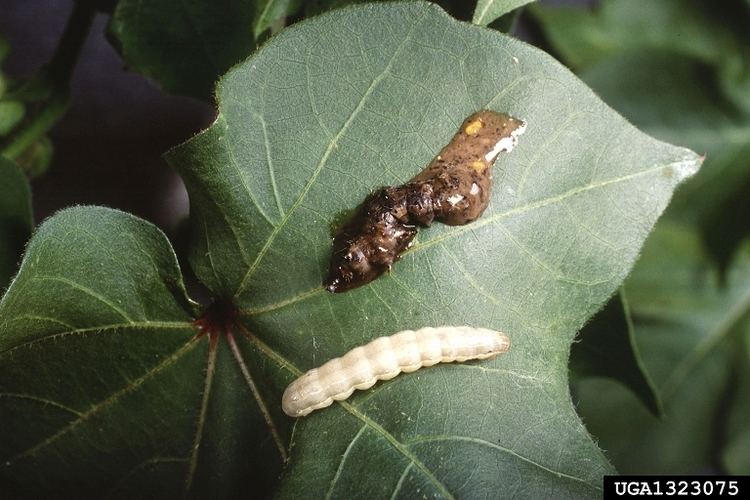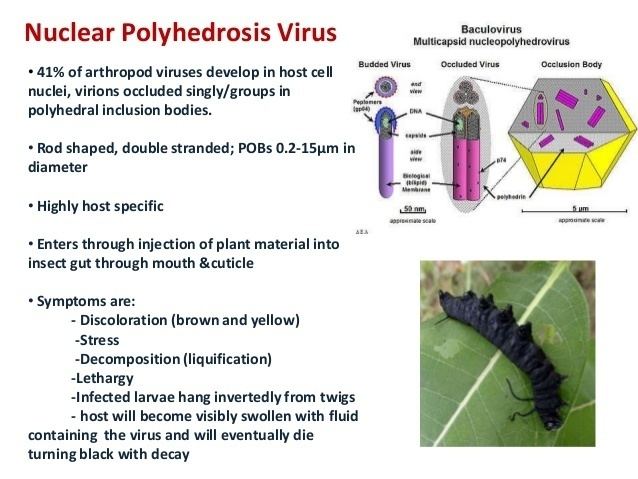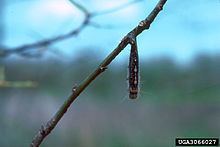Group Group I (dsDNA) Higher classification Alphabaculovirus | Rank Species | |
Similar Baculoviridae, Autographa californica, Autographa, Spodoptera, Fall armyworm | ||
Helicoverpa armigera hbn larval mortality due to nuclear polyhedrosis virus npv mpg
Nuclear polyhedrosis virus was listed as a subgenus (Nuclear polyhedrosis viruses SNPV subgenus) of then-genus Eubaculovirinae at one time by the ICTV, but now refers to 35 species of Baculoviridae, mostly alphabaculoviruses, but also one deltabaculovirus and two gammabaculoviruses.
Contents
- Helicoverpa armigera hbn larval mortality due to nuclear polyhedrosis virus npv mpg
- Recognising Helicoverpa NPV in the field
- Symptoms
- Transmissibility
- Applications
- References

The nuclear polyhedrosis virus (NPV) which belongs to the family Baculoviruses is a virus affecting insects, predominantly moths and butterflies. It has been used as a pesticide for crops infested by insects susceptible to contraction. Though commercialization of the viral pesticide is slow as the virus is very species specific, making it effective under certain circumstances.

The polyhedral capsid is an extremely stable protein crystal which protects the virus in the external environment. It dissolves in the alkaline midgut to release the virus particle and infect the larva.

Heliothis sp. is a cosmopolitan insect pest attacking at least 30 food and fibre yielding crop plants. They have been controlled by the application of NPV's Baculovirus heliothis. In 1975, Environmental Protection Agency, U.S.A. registered the B.heliothis preparations.

Recognising Helicoverpa NPV in the field
Symptoms
Symptoms are:
The virus enters the nucleus of infected cells, and reproduces until the cell is assimilated by the virus and produces crystals in the fluids of the host. These crystals will transfer the virus from one host to another.
The host will become visibly swollen with fluid containing the virus and will eventually die—turning black with decay.
Transmissibility
The virus is unable to affect humans in the way it affects insects: human cells are acid-based, while this virus requires an alkaline-based cell in order to replicate.
It is possible for the virus crystals to enter human cells, but not replicate to the point of illness.
It is transferred from insect to insect through crystals in all of their bodily emissions. As the virus is in the crystal-like capsid, it must be broken down by the alkaline digestive system of the insects to be released.
Mortality in infected insects is nearly 100%
Bleach and ultra-violet light have been found to prove effective in killing the virus.
Applications
Lymantria dispar, a serious pest of forest trees, commonly known as gypsy moth, has been successfully contained by releasing gypsy moth Baculovirus (NPV) preparations.
Another pest of forest trees, species of sawfly (Neodiprion sertifer, N. lecontei, N. pratti pratti, etc.), have been successfully controlled by NPV treatments specific to them.
NPV preparations have also been commercially used against pests such as Trichoplusia (under the biotrol-VTN brand name) and cotton leafworm (Spodoptera litura) (biotrol-VSE brand name).
